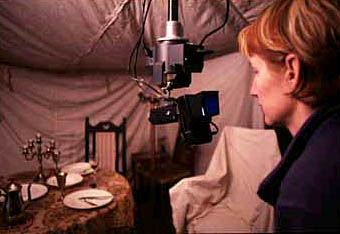
The success of her installations are dependent upon the active participation of her viewers. Installations with a technology twist are a new experience for many students. The viewers ability to perceive reality is altered with every turn. Each viewer carries a hand held video camera and headphones so Janet Cardiff can walk through the distorted reality with them. The artist also explores our relationship to books (a traditional medium of expression) through which our imagination can be transported through time and place in the pursuit of alternative realities. "In Real Time", that premiered at the Carnegie International 1999/00, provided a walk through the library of the museum. The voice of the artist and scenes taped in the library are layered onto the visitor's actual experience of moving through the physical space of the library.
My high school students' responses to this piece were very
positive and they were anxious to get to work creating
their own blurred reality. They were very comfortable
with the technology used in this piece and were eager to
try this new application. The aesthetic qualities of
their works were dependent upon their choice of present
realities.
It showed them some possibilities of using realities and
media common to them and mixing them in a new way.
More of Janet Cardiff's pieces may be found at www.abbeymedia.com/Janweb/ or cmoa.org.